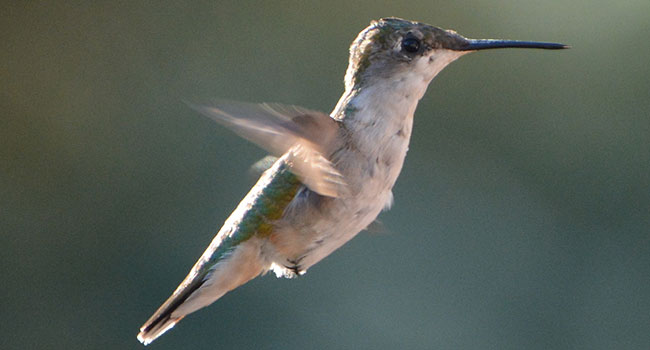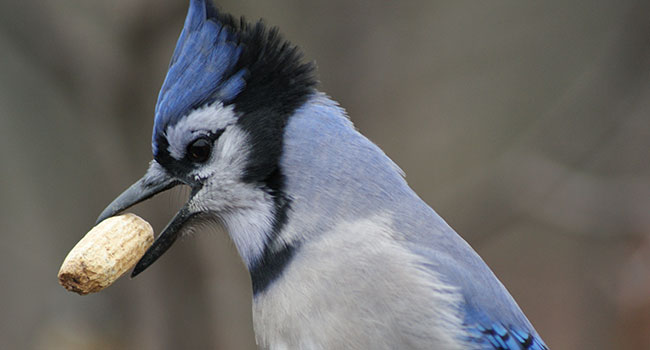
Typically, hummingbirds stake claims to an area in or near a garden, where food is abundant. Photo provided by Geoff Carpentier
 When birds bully others of their own or other species, there are no malevolent feelings involved as is often the case with humans.
When birds bully others of their own or other species, there are no malevolent feelings involved as is often the case with humans.
Bullying is defined as “using superior strength or influence to intimidate, typically by force.”
In essence, this is exactly what happens in nature on a very regular basis. Protection or retention of food sources and supplies, shelter and territory, and even mates are usually the motivating forces behind this aggressive behaviour.
Let’s look at a few examples to demonstrate.
At my house, I have two hummingbird feeders that I keep up all summer and into early fall. It’s well known that hummingbirds are aggressive toward other hummers, during migration and throughout the breeding season.
Typically, a male or female stakes claim to an area in or near a garden, where food is abundant, in this case because the homeowner has provided unlimited quantities of food in the form of colourful feeders or expansive gardens.
The defender will aggressively chase any rival away from the food source and will pursue it over long distances to ensure the interloper doesn’t come back.
However, the draw of the easy pickings means the intruder will try repeatedly to gain access to the food. Sometimes the defender is overwhelmed as two, three or more intruders will come at once and simply grab the food and flee while the defender is distracted chasing another bird.
In my yard, the defender changes periodically – one day a female may guard the food and then a few days later a male does the same. Most often the intruder simply flees when pursued, but sometimes he or she will become involved in a dramatic aerial battle that often leaves both birds exhausted on or near the ground.
The outcome is simple – whoever is strongest wins, as is the case in all aspects of the natural world.
Blue jays are gluttonous feeders that often overwhelm other birds at feeding stations. They sweep in en masse and noisily grab every morsel in sight. Their claim to victory lies in the fact that they are aggressive, fast, large and noisy, often intimidating everything else on the feeder.
The exceptions are usually the mourning doves and common grackles that can stand their ground and eat in relative peace. Northern cardinals are also often able to withstand the onslaught of the blue jay encounters, but not always. Most other birds simply leave and return quickly as soon as the jays are gone. In this case, might always wins.
Sometimes we see smaller birds apparently bullying larger birds of prey. How is this possible? Why would a tiny chickadee attack an owl or hawk and put itself at risk?
The answer is simple. Birds of prey and other predators rely on stealth to capture prey. They stay in hiding, use camouflage and quietly stalk their prey, then pounce at the last second to increase the chances of success. If they’re spotted, they lose the advantage.
There’s a symbiotic relationship amongst small-prey species of birds, whereby they mob a predator – noisily declaring its presence and location to all the other small birds in the area.
No one understands how different species can communicate with each other but there must be a mechanism, since often nuthatches, chickadees, wrens, sparrows and warblers flock together to chase off a predator. They flutter nearby in the face of the predator and make loud vocalizations to identify its presence to others in the flock.
Usually, the hawk or owl simply stoically takes the abuse and eventually the smaller birds lose interest or the bird of prey flies off, often pursued by the tiny flock, to try to hunt elsewhere.
So in nature, true bullies don’t exist, at least not in the context of human actions. But behaviour reminiscent of it can be witnessed regularly as birds strive to survive.
The foundation of life for all things is food, shelter and raising offspring. If a species is to survive, it must aggressively defend these resources or perish.
Geoff Carpentier is a published author, expedition guide and environmental consultant. Visit Geoff online at www.avocetnatureservices.com, on LinkedIn and on Facebook.
The views, opinions and positions expressed by columnists and contributors are the author’s alone. They do not inherently or expressly reflect the views, opinions and/or positions of our publication.

